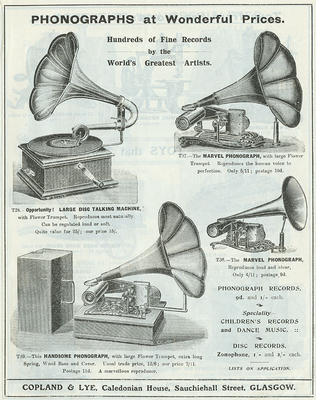
The latest sound reproduction systems have been big sellers at Christmas for at least a hundred years. These phonographs illustrated in Copland & Lye's catalogue of Christmas gifts in 1909 may not be recognisable in the 21st century, but would have caused great excitement in their day.
Thomas Edison recorded his voice on a cylinder phonograph in 1877. Emile Berliner produced the first flat disc recording ten years later. Recording was achieved using a large horn to collect the sound, which translated via a diaphragm to a needle which moved from side to side in a spiral groove. An inside-out mould was then taken from the original master recorded disc. Shellac records were then pressed out between two plates. These records were recorded at a fixed 78 rpm and were played on wind-up gramophones that amplified the sound using only mechanical vibrations from the needle through the large horn. The sound reproduction was poor by modern standards but of a sufficient quality to bring enjoyment to a mass audience. However, the needles caused wear on the records and shellac was very easily broken.
Reference: Glasgow City Archives, TD128/95
Reproduced with the permission of Glasgow City Council, Libraries Information and Learning
Keywords:
Caledonian House, Christmas presents, Christmas shopping, Copland & Lye, department stores, discs, gramophone records, gramophone trumpets, gramophones, horns, music, phonographs, shellac, sound recordings, trade catalogues
You have 0 images in your photo album.